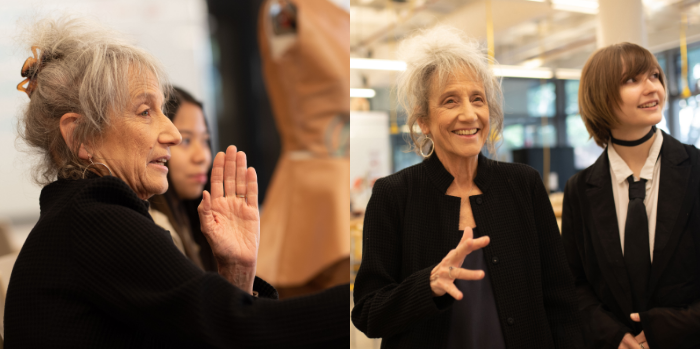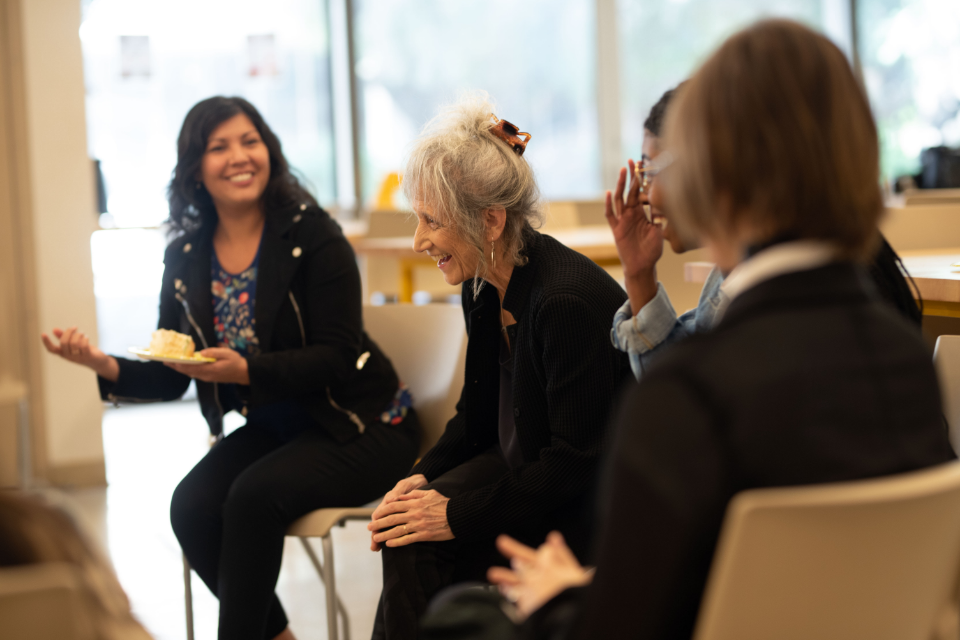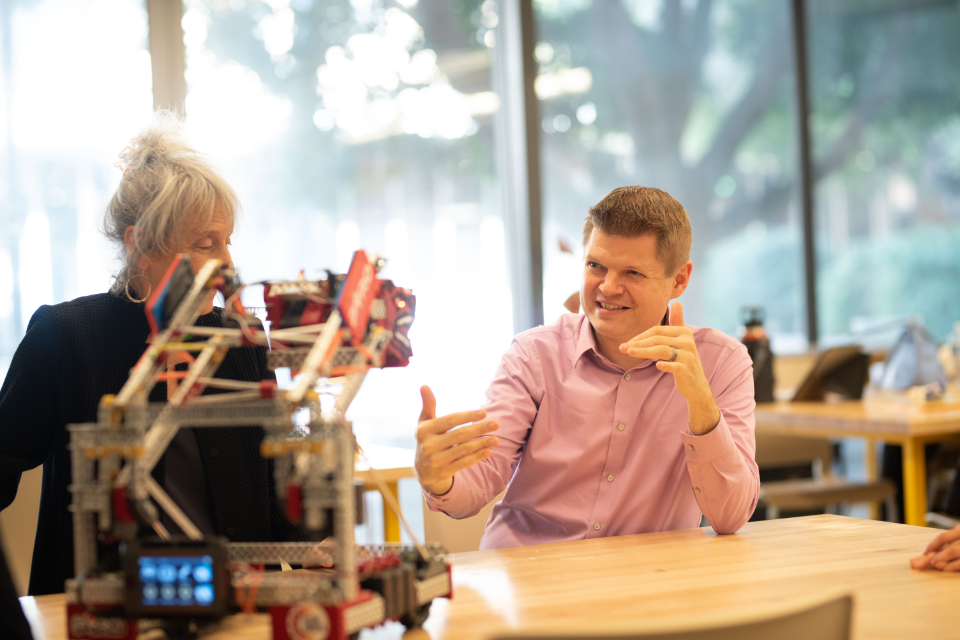Editor's note: This story originally appeared in the spring 2023 issue of ASU Thrive magazine.
The curtain opens on a world premiere. Like magic the show materializes. How many sets of eyes contributed to making it happen? And how did it all come together?
Key questions like this and the answers have always intrigued visionary artist Liz Lerman, a nationally lauded choreographer and recipient of many awards, including the 2011 United States Artists Ford Fellowship in Dance.
Why would anyone want to keep the process of making art a secret, she wondered. Any veteran artist would be quick to admit that a fully formed concept appearing onstage without feedback and revisions is unlikely.
It never happens that way. Ever.
The process of making art involves feedback. Many years ago, Lerman, a professor in the School of Music, Dance and Theatre and a MacArthur “genius” grant fellow, was determined to figure out what kind of feedback situation would leave an artist hungry to get back into the studio to improve their art. And that is how the Critical Response Process was born. It’s been used extensively as a formal process for more than a decade — and was in development and refinement in real-world situations even before then, starting back in 1990.
Not only is CRP being used for providing feedback on artistic creations, but also for engineering concepts, inventions, workplace performance and more.
How it works
The steps of the process are straightforward, but provide profound results in the way they create an environment where everyone learns and improves their communication skills.
CRP is an elastic process. It can be a formal experience in a designated time and place with a performance or presentation, or it can be scaled down for a work or home situation. You can share something as large as an opera or something as small as a recipe. Flexibility is built into the steps.
Learning the process can happen in a few minutes, but practicing it can be a lifelong process. Some facilitators and practitioners have made it central to their understanding of how judgment can be engaged and suspended — whether in their personal or professional lives — and see honing communication skills as a continuous journey.
You can take a workshop, or read Lerman’s new book to see how it unfolds in various settings. You can also read through these steps and try it right now.
Most often, the process begins with a showing of a work in progress that can be an art piece, a grant application, brochure content or even a very early idea.
Generally, participants sit in a circle. There are three roles: artist/maker, facilitator and responders. You can use the process with a room full of responders or just one.
Step 1: Statements of Meaning
After listening to the performance or idea, or after reading or viewing the artwork, responders state what was meaningful, evocative, interesting, exciting or striking in the work or idea.
Statements can be very specific, for example, “When you were leaping across the downstage diagonal I really felt your forward momentum.” Or they can be more general, “I really appreciated all the research you put into your subject.”
Lerman describes the feeling in the room after step 1 as “amazing.” The initial statement uplifts the artist/maker and everyone else. It also provides useful information often not experienced inside most systems of feedback.
It is understood that observers may see problems in the work, and this is important, but they hold those comments for later.
Step 2: Artist as Questioner
The artist/maker asks questions about the work or the idea. In answering, responders stay on topic and express opinions in direct response to the artist’s questions.
This can be applied to any situation where an artist/creator desires feedback to motivate them to get back to work with ideas of how to improve it. This step places the process in the hands of the artist/maker. They decide what gets discussed first and allows them to address what is most worrisome.
Lerman notes how important this creator-driven step is because it gives the responders insights into where the artist/creator is coming from and provides context for critiquing the work.
Step 3: Neutral Questions
Responders ask neutral questions about the work, and the artist responds. Questions are neutral when they do not have an opinion couched in them. For example, a question like, “Why was the music so faint?” embeds the opinion that you felt like you could not hear it. If you reframe the question to, “Can you talk about the process of selecting the music and the music’s volume?” you will learn more about the artist’s intention in using that particular selection. It keeps responders curious for a longer amount of time and might even affect their opinion.
Step 4: Opinion Time
Responders state opinions if and only if they are given permission from the artist or receiver; the artist/receiver has the option to say no. For example, the responders can say, “I have an opinion on your choice of the composer, would you like to hear it?”
At the heart of CRP is the agency of the artist/maker. They decide how the process unfolds in a way that will be most useful to them in honing their work.
Using cake as the “artwork” provides a low-stakes way to learn how to ask for and provide feedback as part of the Critical Response Process.
In the workplace
Phil Stoesz, design expert and facilitator for the University Design Institute, an ASU unit that strives to transform traditional educational models, helps train people to use Lerman’s CRP in work environments.
“The process is dynamic, and is so easily adapted to work environments,” Stoesz says. “Too often feedback is owned by the bosses. In CRP, we give the power to employees too.”
In addition to facilitating CRP workshops for artists and teachers, Stoesz, a CRP-certified facilitator, co-founded ReCreate, which brings the method to the workplace. Recently, Stoesz was part of a team that introduced CRP to a security team at Google.
According to Stoesz, step 1 is natural as it’s common for bosses to cheer on their employees.
Steps 2 and 3 provide valuable insights. “Employees bringing questions to their supervisors reveals their curiosity about their work,” he says. Step 3 allows the supervisor to learn more before delivering an opinion, he adds.
During trainings, Stoesz often brings in cookies as the “artwork” to learn the steps in a low-stakes situation, a practice Lerman and colleagues introduced into the process years ago.
He sees CRP as the future of workplace feedback, adding, “the process gives agency to workers and builds a better work culture.”
In academics
Shawn S. Jordan, an associate professor at the Ira A. Fulton Schools of Engineering, has seen how useful CRP can be in classrooms.
“I had already heard about Lerman’s work from a colleague, but was delighted to learn that she was working at my own institution,” he says. “I was immediately engaged and inspired by CRP’s mindset.”
When a CRP class was offered to the participants of a leadership group, Jordan signed up. The class included a broad range of the ASU community.
“The mix really showed me the breadth at which this work could be applied,” recalls Jordan. “Engineers design solutions and products that need feedback. But the usual way is to pick a design concept apart, which is not consent-based and affects confidence.”
Jordan found that CRP works well for giving feedback on engineering solutions.
“With CRP, the control is in the hands of the designer,” he says. “It’s a positive experience, and they are more likely to stay in engineering.”
Jordan is one of many faculty members across disciplines who use the process to provide more meaningful feedback to learners — and to help teach students how to provide insightful feedback.
“With CRP, the control is in the hands of the designer. It’s a positive experience, and they are more likely to stay in engineering,” says Shawn S. Jordan, an associate professor at the Ira A. Fulton Schools of Engineering.
Critical Response Process resources
This past July, Wesleyan University Press published “Critique Is Creative: The Critical Response Process in Theory and Action,” written by Lerman in collaboration with her longtime colleague John Borstel. The book includes stories about the process in action from the past 30 years. It’s an excellent resource for getting comfortable using the process in your own life.
“We worked really hard figuring out the structure of the book,” Lerman says. “It’s simple, straightforward and not fancy.”
Lerman’s dream for the book is that more people will find out about the process. “I hope they will be excited about the variations they see,” she says. “Live with it, try it and read these stories.”
Another way to become more adept with the process is to take a workshop with Lerman or a CRP-certified practitioner. Lerman coaches everyone along and sometimes halts the process to return to a previous step to go deeper, points out Sumana Sen Mandala, a CRP-certified practitioner, or to explain the step’s purpose better.
“I was struck and continue to take inspiration from this ‘time out’ idea in CRP,” Mandala says. “There is such wisdom in the reflections Lerman does on the spot on the way the group is using the process.”
Another idea is to consider working with teachers who use CRP in their arts programs or classrooms. However you go about working with CRP, Lerman encourages you to begin trying it and practicing it.
Apply the Critical Response Process
Go to lizlerman.com/critical-response-process to watch videos demonstrating the process, see upcoming training opportunities and more.
Story by Nancy Wozny, editor in chief of Arts and Culture Texas and frequent contributor to Pointe, DanceTeacher and Dance Magazine, and winner of the Gary Parks Award from the Dance Critics Association.
Top photo: Robotics lead Kenneth Hodson, student Charles Jeffries, Liz Lerman and Shawn Jordan practicing the Critical Response Process for feedback on an engineering project. Photos by Courtney Lively, a Scholar All-Region Athlete on ASU’s soccer team, who graduated in ’07 with a BIS in interdisciplinary studies. As an event and brand photographer, Lively’s clients include Deloitte, Google and others.
More Arts, humanities and education

ASU professor's project helps students learn complex topics
One of Arizona State University’s top professors is using her signature research project to improve how college students learn science, technology, engineering, math and medicine.Micki Chi, who is a…

Award-winning playwright shares her scriptwriting process with ASU students
Actions speak louder than words. That’s why award-winning playwright Y York is workshopping her latest play, "Becoming Awesome," with actors at Arizona State University this week. “I want…

Exceeding great expectations in downtown Mesa
Anyone visiting downtown Mesa over the past couple of years has a lot to rave about: The bevy of restaurants, unique local shops, entertainment venues and inviting spaces that beg for attention from…





